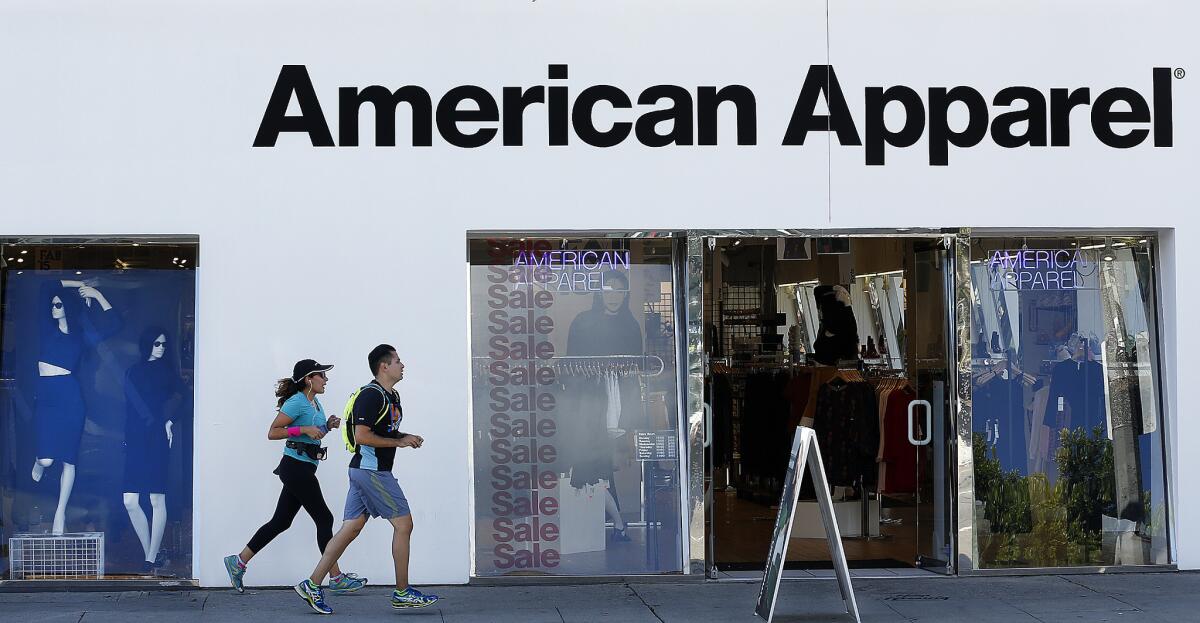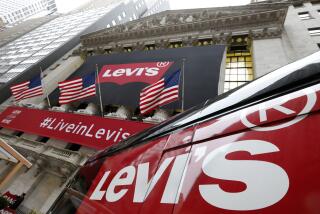American Apparel files for bankruptcy but may need to do more to survive

American Apparel net losses have totaled nearly $384 million over the last 5 1/2 years.
American Apparel, the Los Angeles clothier that was once a fashion trailblazer, took a drastic step to stave off financial ruin — a move that may still not be enough to save the company.
On Monday, the clothing manufacturer and retailer filed for Chapter 11 bankruptcy protection after reaching a deal with 95% of its secured lenders. The restructuring agreement, which will take the company private and hand nearly 100% control to its largest bondholders, is designed to cut its crippling debts and interest payments.
If approved by the Bankruptcy Court, the deal would also force out most of American Apparel’s shareholders, including founder Dov Charney, who was ousted last year as chief executive and chairman.
Paula Schneider, who came aboard as chief executive in January, said filing for Chapter 11 was “the right decision for the company.”
“The debt structure was the biggest impediment that we have,” she said. “When you have over $300 million in debt and are paying $35 million-plus in interest rates, it’s not a sustainable business model.”
That lack of cash, Schneider said, forced her to make hard decisions.
“We had no liquidity,” she said. “We were making choices every day of funding retail or wholesale or e-commerce.”
The restructuring agreement will enable the company to continue following its core mission — manufacturing in the U.S., Schneider said. It will also solve the company’s immediate cash crunch. No layoffs are planned, but a “small number” of underperforming stores will close, she said.
Analysts said that despite the reduction in debt, American Apparel’s underlying problems remain: lackluster product offerings, too many stores and high production costs, with about 4,600 manufacturing and sewing employees in Southern California. The company employs 8,500 workers worldwide.
Schneider said she plans to continue with a turnaround plan that includes freshening up products, streamlining offerings and reducing costs.
For the last several months, American Apparel has been focused on launching fall fashions that were supposed to showcase the company’s new creative direction. But because of the cash crunch, only about 15% to 20% of the new products were made, Schneider said.
“We designed a really beautiful fall line,” she said, “and we simply couldn’t afford it all by any stretch.”
But some analysts said that American Apparel will have to make more drastic changes if it hopes to survive.
“It will certainly be easier to craft a turnaround as a private company, but nothing addresses the basic problem — that nobody wants their merchandise,” said Josh Arnold, an equities analyst and contributor to financial site Seeking Alpha.
American Apparel’s net losses have totaled nearly $384 million over the last 51/2 years. Sales have continued to slip from the 2013 peak of $633.9 million, despite $30 million in cost cutting. In the three months that ended June 30, American Apparel suffered a 17% decline in revenue to $134 million, the fourth straight quarterly drop.
The stock has dropped so low — closing at 11 cents Friday — that the New York Stock Exchange warned American Apparel last month that the company did not meet its continued listing standards.
The company must regain its youthful customers, who have flocked in recent years to fast fashion rivals such as Zara and H&M. The same fickle shoppers have also abandoned once trendy retailers such as Abercrombie & Fitch and Wet Seal.
“The millennials who were voracious consumers of this product five, 10 years ago, many are now over 30 and their tastes and preferences have evolved,” said Matt Covington, a managing director at Conway MacKenzie, a financial consulting firm that specializes in bankruptcy transactions. “They need to find a way to get relevant again.”
Some experts said the company must reduce labor costs by outsourcing at least part of its manufacturing to another country. Shifting production to a lower-cost region would help, especially after the city of Los Angeles hikes the minimum wage to $15 an hour by 2020, analysts said.
“It’s difficult to see how they can continue to be a made-in-California brand or a made-in-Los-Angeles brand,” Covington said.
Schneider, however, said outsourcing is not an option.
“You can’t have American Apparel without apparel made in America,” she said. “It’s what sets us apart and what makes us different.”
Analysts said the company should also consider closing some overseas stores — something that American Apparel said it is not doing.
As many as half of the company’s 230 stores worldwide could be unprofitable, analyst Arnold said. It makes no sense to continue operating in places like Ireland and Spain, which have only one store in the entire country, he said
Under its deal with creditors, more than $200 million in bonds would be eliminated in exchange for shares in the reorganized company — known in business as a debt-for-equity swap. The participating lenders are Monarch Alternative Capital, Coliseum Capital, Goldman Sachs Asset Management, Pentwater Capital Management and Standard General.
Creditors have agreed to provide American Apparel with $90 million of debtor-in-possession financing, and have committed an additional $70 million in capital to support the restructuring of the company, American Apparel said. That should reduce the company’s debt from more than $300 million to no more than $135 million, American Apparel said. Annual interest payments will be reduced by more than $20 million. (The company was facing a $13.9-million interest payment due Oct. 15 but didn’t have the cash to pay it).
But existing shareholders would be left with nothing. Charney, who was fired last year after an investigation into alleged inappropriate behavior with employees and misuse of company funds, will fight the bankruptcy plan, analysts said. Charney has denied the allegations, and in one lawsuit alleged that his ouster was part of a plot to get him out of the way so the company could be sold. Charney declined to comment.
American Apparel must still contend with workers who have staged numerous protests over the last year amid efforts to unionize.
Workers “feel deceived,” said Nativo Lopez, a senior advisor with Hermandad Mexicana, which is working closely with employees. “There has been one promise after another that things will remain the same and their wages and salaries will be paid. There is incredible uncertainty.”
American Apparel, which has avoided several brushes with financial catastrophe over the years, could come out of bankruptcy with the best chance of a turnaround it has had in years, analysts said. The company said the reorganization would take about six months.
“It’s like a rebirth,” said Lloyd Greif, chief executive of Los Angeles investment banking firm Greif & Co. “In all aspects of the operation, they can make changes.”
shan.li@latimes.com
Twitter: @ByShanLi







